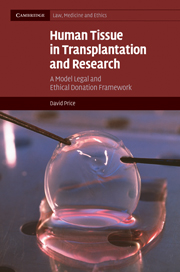Book contents
- Frontmatter
- Dedication
- Contents
- Preface
- Table of cases cited
- Table of selected statutory sources
- Introduction
- 1 Human biological materials
- 2 Interests in the living body and corpse
- 3 Eliciting wishes
- 4 Consent to donation
- 5 Presumed consent
- 6 Informed consent
- 7 Living donation
- 8 Property in human material
- Conclusion
- Index
- References
7 - Living donation
Published online by Cambridge University Press: 05 July 2014
- Frontmatter
- Dedication
- Contents
- Preface
- Table of cases cited
- Table of selected statutory sources
- Introduction
- 1 Human biological materials
- 2 Interests in the living body and corpse
- 3 Eliciting wishes
- 4 Consent to donation
- 5 Presumed consent
- 6 Informed consent
- 7 Living donation
- 8 Property in human material
- Conclusion
- Index
- References
Summary
Living donation is the backbone of many organ transplantation systems and a vital and substantial supplement to deceased donation in many others. It is being increasingly relied upon in many developed transplant nations, as rapidly rising demand for organ replacement therapy outstrips available supply. As the European Commission stated ‘The use of living donors is an increasing alternative given the failure to meet the growing need for organs with cadaver donation’. By virtue of the typically more limited harms normally associated with the removal and use of tissue for transplantation or research, the primary focus here is upon organs for transplant. Not only has there been rapid growth in living donation rates in many parts of the world, but policies have largely come to embrace living donation as a standard therapy. This policy shift can be seen in the new regime in the Human Tissue Act 2004 and the Human Tissue (Scotland) Act 2006, which implicitly confer legitimacy and support by way of comprehensive monitoring. It can also be witnessed at an international level in the statements of the Council of Europe and the World Health Organisation (WHO), seemingly to cater for an ever-increasing reality and predicament. Whilst atypical, in certain jurisdictions, including the US, such procedures are not governed by specific laws and, subject to general guidance (from the United Network for Organ Sharing (UNOS) in the US), are dictated by individual centre policies.
But whilst living organ donation has now become ‘mainstream’, and regarded as a crucial element of a successful donation strategy in many regions, it has always been controversial. Even today some critics maintain that it is an illegal practice which contravenes the moral and ethical proscription of non-maleficence, or primum non nocere, perhaps implicitly harking back to the early Thomistic notion of totality. Scheper-Hughes has also alluded to the ‘tyranny of the gift’ in this context, alleging that even living related donation is more accurately described as ‘poaching’ than a voluntary act of giving.
- Type
- Chapter
- Information
- Human Tissue in Transplantation and ResearchA Model Legal and Ethical Donation Framework, pp. 196 - 229Publisher: Cambridge University PressPrint publication year: 2009



